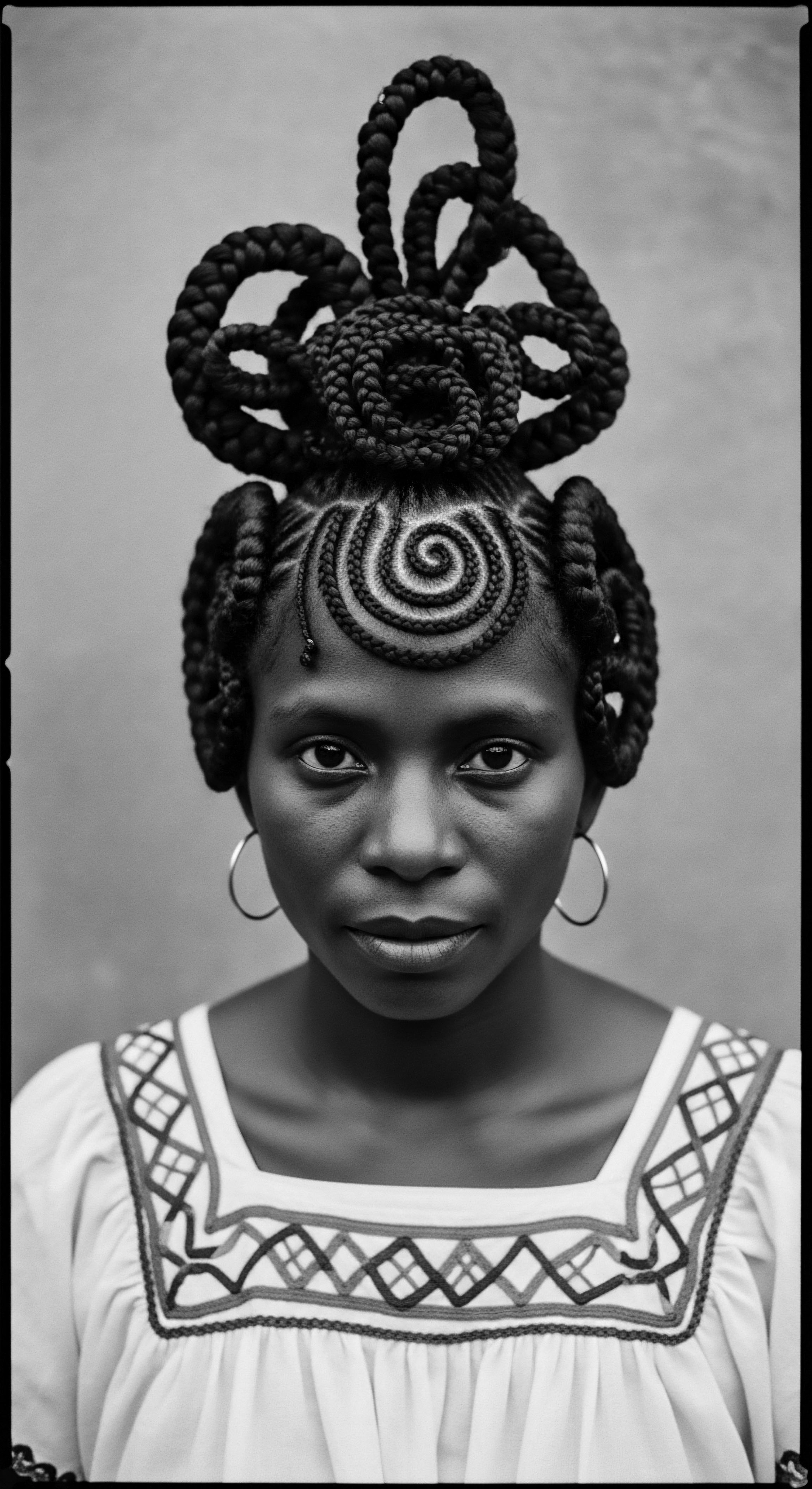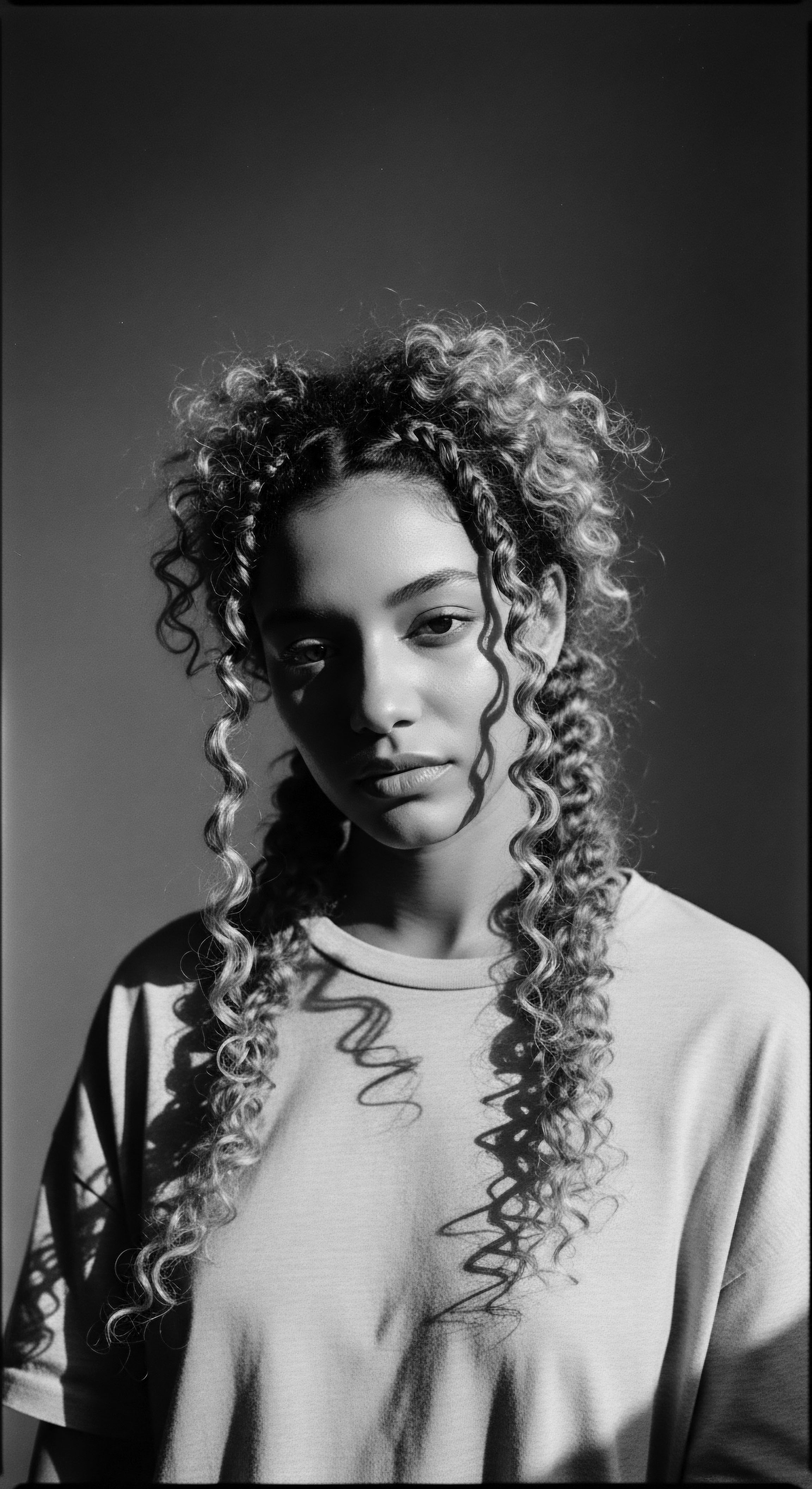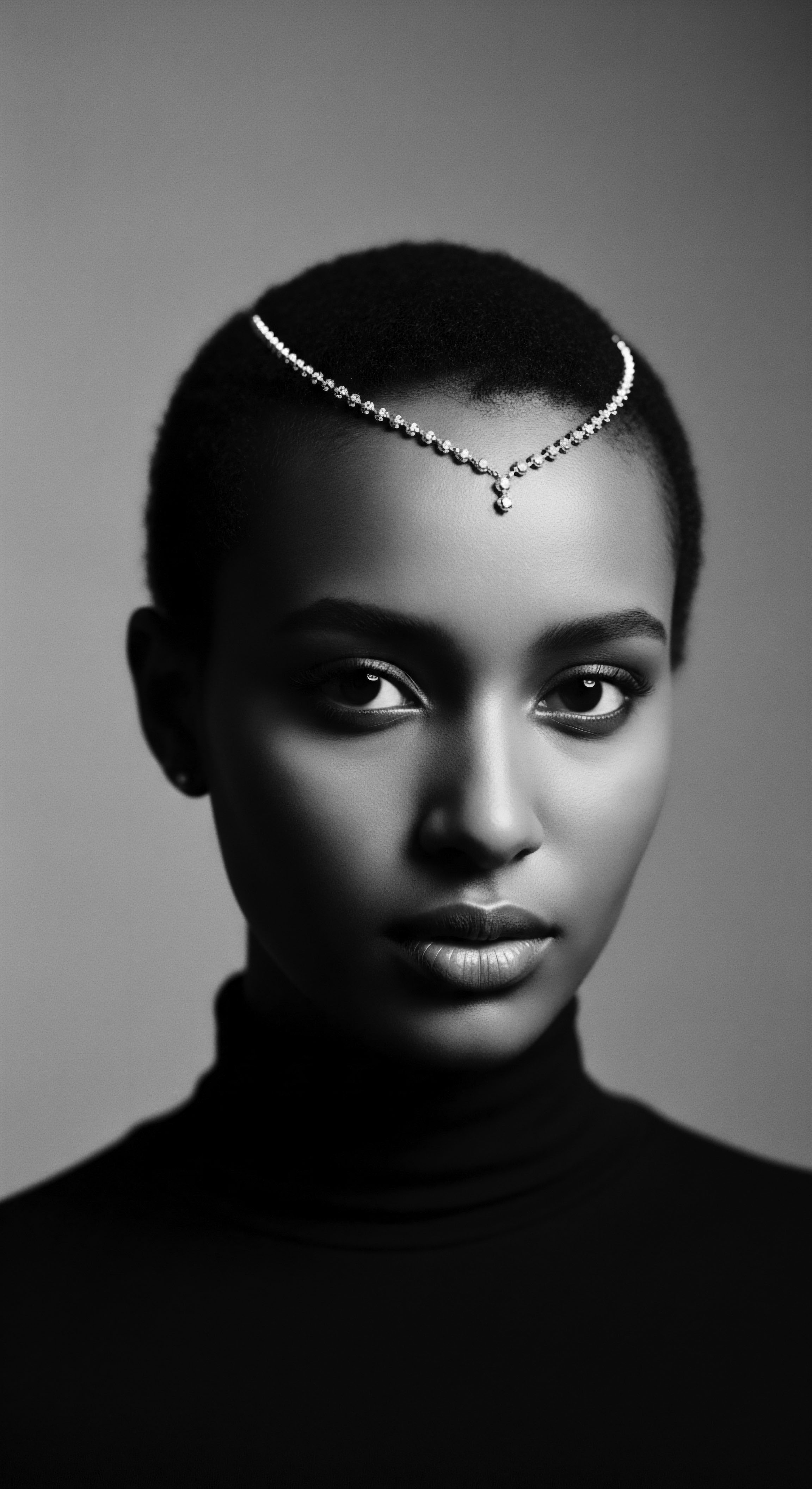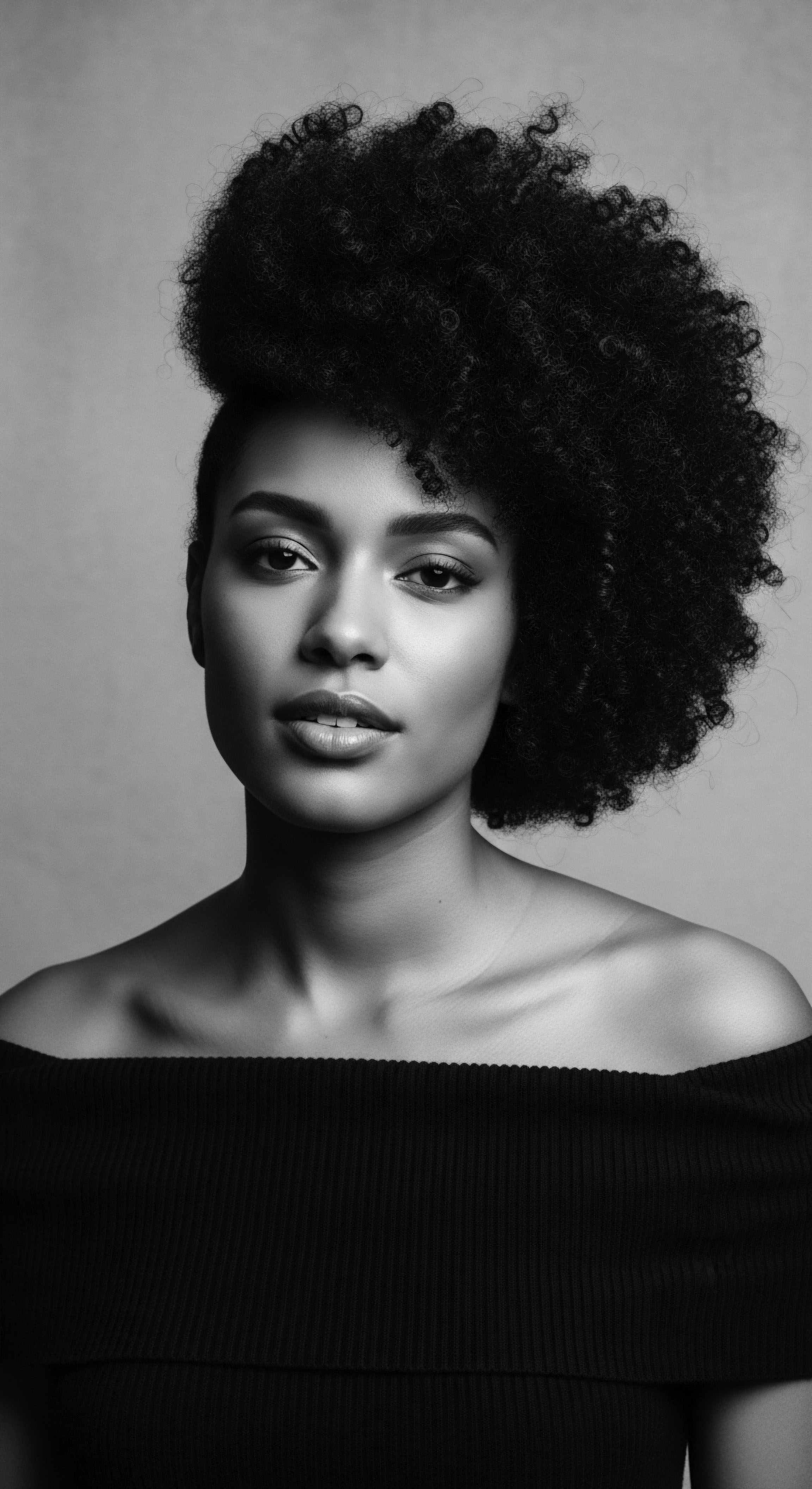
Fundamentals
The concept of Traditional Hairpins, when viewed through the rich lens of textured hair heritage, extends far beyond simple adornment. At its initial approach, a Traditional Hairpin can be understood as a practical implement, a slender device fashioned from various materials, serving primarily to secure, arrange, or decorate hair. Its fundamental purpose involves holding sections of hair in place, whether gathered in a bun, coiled into an intricate updo, or braided close to the scalp. This basic function, however, merely scratches the surface of its profound significance across communities, especially those with deeply rooted hair traditions, such as Black and mixed-race peoples.
Across ancient civilizations, hairpins were indispensable tools in daily life and ceremonial practices. Their construction varied widely, reflecting the ingenuity and available resources of distinct cultural groups. Early hairpins might have been rudimentary sticks or sharpened bones, yet even these simple forms carried a weight of communal meaning. Over millennia, human hands crafted these instruments from an array of substances ❉ polished wood, carved bone, wrought iron, gleaming brass, and even precious metals like gold and silver.
Each material choice often signaled something about the wearer or the artisan, speaking to local ecology, trade networks, and artisanal skill. The selection of a particular material could indicate social standing or the purpose of the hairpin, distinguishing between everyday use and special occasions.
Traditional Hairpins, beyond their practical role in styling, serve as tangible links to the historical, cultural, and spiritual landscapes of Black and mixed-race hair traditions.

Elemental Design and Early Meanings
The fundamental explanation of a Traditional Hairpin begins with its design ❉ a shaft, typically straight or gently curved, with a decorative head or a functional end that facilitates its insertion into hair. This seemingly straightforward design allowed for a multitude of variations tailored to specific hair textures and cultural aesthetics. For millennia, before the advent of modern elastic bands or synthetic clips, these pins provided a secure and elegant means of managing hair.
The earliest known African hair comb, a close cousin to the hairpin in its functional and symbolic role, dates back 5500 years, evidencing the enduring human commitment to hair care and adornment. Such longevity speaks to the foundational utility and adaptability of these simple tools in the human experience.
From the earliest iterations, the meaning of hairpins was rarely limited to utility alone. They became extensions of personal and collective identity. The act of inserting a hairpin often became a ritualistic gesture, connecting the individual to a broader collective understanding of beauty, status, and heritage. As societies evolved, so too did the complexity and symbolism of these hair accoutrements, embodying layers of cultural information within their very form.

Tools of Expression Across Ancient Africa
Within pre-colonial African societies, the hair, and by extension, the tools used to style it, held profound cultural and spiritual significance. Hairstyles communicated a wealth of information, from one’s ethnic origin and marital status to age, wealth, and even spiritual beliefs. Hairpins were integral to these elaborate coiffures.
They secured intricate braids, supported towering constructions, and served as markers of identity. For instance, among the Igbo people of Nigeria, hairpins were not merely functional but were often long, thin, and graced with intricate designs, adding sophistication and visual storytelling to hairstyles.
These traditional hairpins acted as silent communicators, allowing individuals to convey their place within the community without uttering a single word. They represented a dialogue between the wearer and their ancestral lineage, a continuous visual affirmation of cultural values. The careful selection and placement of a hairpin became a deliberate act of self-expression, deeply rooted in the collective memory of a people.

Intermediate
Moving beyond the foundational understanding, the Traditional Hairpin assumes a more intricate meaning, reflecting its deeper role within hair practices, particularly those associated with textured hair. Its significance, a layered tapestry of cultural importance, functional ingenuity, and symbolic resonance, extends beyond mere utility into the realm of identity and communal practice. These seemingly simple tools served as custodians of ancestral knowledge, embodying methods of care and adornment passed through generations.
The Traditional Hairpin often acted as a silent anchor for complex, gravity-defying styles characteristic of many African hair traditions. Its presence facilitated the creation of protective styles that safeguarded fragile hair strands, a wisdom deeply embedded in ancestral care rituals. The intricate coiling and braiding techniques, often requiring precision and patience, found their stability with the discreet yet firm hold of a well-placed hairpin. Such practices were not simply about aesthetics; they prioritized the health and longevity of the hair, acknowledging its inherent vulnerability and resilience.
The Traditional Hairpin embodies not just a tool for styling, but a vessel for ancestral knowledge, cultural resilience, and the enduring celebration of textured hair.

Ancestral Echoes in Materiality and Craft
The materials from which traditional hairpins were forged—wood, bone, ivory, metals like iron, copper, and brass—speak volumes about the environments and metallurgical skills of diverse African communities. Each material carried its own set of properties, chosen for durability, availability, or symbolic association. For example, conical hairpins of copper or iron were important objects forged by Luba blacksmiths to remember past royals, as noted in the exhibit “Hair in African Art and Culture.” This connection between a styling implement and a historical remembrance transforms the object from a mere tool into a piece of living history.
- Wood ❉ Readily available, often carved with symbolic motifs that mirrored the community’s connection to nature and spirituality. A wooden hair bodkin from Tanzania speaks to this legacy.
- Bone/Ivory ❉ Requiring specialized carving techniques, these materials indicated skill and often status. Intricately carved bone hair ornaments were significant accessories in Igbo hairstyling.
- Metals ❉ Iron, copper, and brass pins from regions like West Africa, including those from the Aviele people of Nigeria, demonstrate sophisticated metallurgical practices. These could also serve various purposes, from ornamentation to signaling social or marital status.
The craftsmanship applied to these pins elevated them from functional items to works of art. Decorative elements such as spirals, crosshatchings, and abstract figures, like those seen on brass hairpins from Agbede, Nigeria, reveal the artistic sensibilities embedded within utilitarian objects. This dedication to beauty in everyday items underscores a deep respect for personal presentation and cultural expression.

Beyond Adornment ❉ Social and Spiritual Markers
The Traditional Hairpin’s historical implication extends far beyond mere decoration. It often served as a visual cue for social categorization. In various African societies, hairpins could indicate a person’s age, marital status, or rank in society. This semiotic role meant that understanding the placement and style of hairpins was akin to reading a communal language, a nuanced form of non-verbal communication.
Consider the Yoruba people, for whom hair was considered the most elevated part of the body, and braided hair was used to send messages to the gods. Hairpins, therefore, might have played a role in securing these spiritually significant styles, becoming part of a sacred ritual. Their presence could signal religious affiliation or denote a spiritual journey. This connection to the spiritual realm imbues the hairpin with a profound, almost sacred, import, reflecting a holistic worldview where the physical and metaphysical intertwine seamlessly.
The cultural import of hair and its adornments also becomes especially poignant when examining the experiences of enslaved Africans. During the transatlantic slave trade, one of the first acts of dehumanization imposed upon enslaved individuals was often the forced shaving of their heads. This deliberate act aimed to strip them of their identity and cultural ties. Yet, even in the face of such brutality, a profound resilience emerged.
Enslaved Africans adapted, innovating with what little was available to maintain their hair. They used natural butters, animal fats, or even repurposed farm tools for grooming their textured hair. Braiding, often secured by improvised pins or other means, became a quiet yet powerful act of resistance and identity preservation. Cornrows, in particular, were used to create secret maps and messages, with patterns representing escape routes along the Underground Railroad, sometimes even concealing small tools or seeds for survival. This poignant historical example underscores the hairpin’s connection to survival, ingenuity, and cultural persistence against overwhelming odds.

Academic
The Traditional Hairpin, interpreted through an academic lens, represents a complex artifact woven into the fabric of human material culture, semiotics, and socio-historical power dynamics, particularly within the contexts of textured hair, Black experiences, and mixed-race heritage. Its meaning extends beyond a simple tool to a multifaceted symbol, a tangible manifestation of ancestral wisdom, identity construction, resistance, and evolving beauty paradigms across diverse diasporic communities. A rigorous examination reveals its profound implications in understanding historical processes of cultural transmission, adaptation, and contestation over aesthetic norms.
Fundamentally, the Traditional Hairpin is a non-verbal communicator, a visual lexicon embedded within specific cultural grammars. Anthropological studies consistently show that hair adornment in African societies was never a superficial act. It served as a sophisticated system of classification and communication, indicating an individual’s membership in a particular ethnic group, their social standing, marital status, age-set, or even their spiritual connection to the cosmos.
(Sieber & Herreman, 2000) For instance, the elaborate intricacies of pre-colonial Nigerian hairstyles, often secured with carved wooden or ivory pins, were works of artistry signifying community roles or status. This systematic encoding of identity through hair and its accompanying implements speaks to a deep, embodied knowledge system that governed social interaction and communal understanding.
Traditional Hairpins serve as profound archaeological markers and ethnographic indicators, providing substantive insights into ancient hair technologies, social hierarchies, and the enduring human practice of self-definition through adornment.

Biocultural Intersections ❉ Hair Biology and Traditional Care
From a biocultural perspective, the design and application of Traditional Hairpins often reflect an intuitive understanding of textured hair’s unique structural properties. Textured hair, characterized by its elliptical cross-section and varying curl patterns (from wavy to tightly coiled), is inherently prone to dryness and breakage due to its structural geometry and fewer cuticle layers that lay flat compared to straight hair. Traditional practices, often employing hairpins to secure protective styles like braids, twists, and coiled formations, inherently minimized mechanical stress and environmental exposure.
This ancient wisdom, passed down through generations, effectively mitigated damage, retained moisture, and promoted hair health. The very act of gathering hair with a pin, rather than subjecting it to constant manipulation, demonstrates a deep, experiential knowledge of hair biology long before modern scientific inquiry.
The use of natural ingredients alongside these physical tools further underscores this biocultural synergy. Shea butter, coconut oil, and various herbal preparations were routinely applied to moisturize and condition hair, often as part of communal grooming rituals. Modern scientific understanding, while utilizing advanced chemical analysis, often validates the efficacy of these ancestral remedies.
For instance, the fatty acids in shea butter and coconut oil are now known to penetrate the hair shaft, providing deep conditioning and reducing protein loss, a scientific affirmation of practices honed over centuries. (La Pocion Ancestral Hair Mask, 2023) The Traditional Hairpin, therefore, is not merely a static object but a dynamic element within a comprehensive, historically validated hair care system.

The Legacy of Resistance ❉ Hairpins in the Diaspora
The narrative of the Traditional Hairpin becomes particularly poignant when examining its trajectory through the transatlantic slave trade and its aftermath. The deliberate shaving of African hair by slave traders functioned as a brutal act of psychological warfare, an attempt to sever cultural identity and strip individuals of their personhood. Denied access to traditional tools and products, enslaved Africans demonstrated extraordinary resilience and ingenuity. They improvised, using materials at hand such as butter, bacon fat, goose grease, or even axle oil to manage their hair.
Within this oppressive context, hair, and any means of styling it, became a profound site of resistance. Braiding, a communal activity in Africa that fostered bonding and cultural transmission, persisted as a clandestine act of defiance. Cornrows, in particular, transcended mere aesthetics, serving as intricate communication systems. Enslaved individuals braided patterns that secretly mapped escape routes or concealed rice seeds for survival on their arduous journeys, as documented in historical accounts.
While direct evidence of specialized “escape hairpins” might be scarce, the fundamental principle of using available implements to maintain or secure these vital, coded hairstyles undoubtedly relied on the spirit of the traditional hairpin—any object capable of holding hair in purposeful formation. This adaptation highlights the profound link between hair practices, survival, and the enduring human spirit.
Post-emancipation, the struggle for hair autonomy continued. The imposition of Eurocentric beauty standards led to immense pressure on Black individuals to chemically straighten their hair to conform to societal norms and gain economic opportunities. A telling statistic from a 2023 survey illuminates this enduring legacy ❉ 61% of Black Respondents Reported Using Chemical Straighteners Because They “felt More Beautiful with Straight Hair,” Despite Knowing the Association with Adverse Health Outcomes Like Early Puberty, Uterine Fibroids, and Cancer. This data point reveals the internalized impact of generations of hair discrimination, where the inherent beauty of textured hair was pathologized and deemed “unprofessional.” The traditional hairpin, therefore, stands as a quiet counter-narrative, a symbol of inherent beauty and self-acceptance that predates and resists these imposed standards.
The cyclical re-emergence of natural hair movements, particularly the Civil Rights Era’s embrace of the afro, represents a reclamation of cultural heritage. The afro pick, a modern iteration of the traditional comb, became a powerful symbol of Black pride and activism during this period, often featuring the clenched Black fist. This evolution demonstrates how hair tools, including the spiritual descendants of traditional hairpins, continue to act as political statements and affirmations of identity.

The Socio-Cognitive Delineation of Hairpins in Cultural Contexts
The traditional hairpin’s significance transcends its material form to encompass its role in shaping social cognition and collective memory. Its presence within a hairstyle could signal a woman’s readiness for marriage, her status as a mother, or her position within a specific social stratum. This semiotic density transformed hair into a complex, readable text.
The Igbo, for example, had distinct hairstyles like Isi Ojongo, a crested design often adorned with ornaments, and Ishi Owu, or African threading, which involved wrapping hair with black thread to create protective styles. Hairpins were integral to these elaborate constructions.
The practice of collective hairstyling, often central to African traditions, highlights the social function of hairpins. These were moments of intergenerational knowledge transfer, community bonding, and emotional exchange. Women would gather, sharing stories and wisdom while meticulously braiding and adorning hair, transforming a practical necessity into a profound social ritual. The communal aspect of hair care, where hairpins were shared tools in a shared experience, underscores their role in strengthening social cohesion and transmitting cultural narratives.
Hairpins also hold a place in the broader textile arts, where hair itself is considered a fiber. Artists like Sonya Clark, an American artist of Scottish, African, and Jamaican heritage trained in textile arts, explore ancestral connections by using hair as a textile art form. She notes that hair, as DNA, connects and separates humans, serving as a foundation for artwork that questions identity, race, culture, and history. This artistic interpretation further elevates the understanding of hairpins, positioning them within a continuum of human creative expression that intertwines personal identity with collective cultural memory.
| Aspect of Traditional Hairpin Functional Role |
| Pre-Colonial African Context Secured elaborate styles (braids, coils), provided stability for towering coiffures. |
| Diasporic Experience (Slavery to Present) Adapted for protective styles (cornrows, headwraps) as acts of resistance. |
| Scientific/Care Insight Today Modern pins maintain style without excessive tension, supporting hair health and reducing breakage. |
| Aspect of Traditional Hairpin Material Composition |
| Pre-Colonial African Context Crafted from wood, bone, ivory, iron, brass, reflecting local resources and skill. |
| Diasporic Experience (Slavery to Present) Improvised from available materials, signifying resilience and resourcefulness. |
| Scientific/Care Insight Today Contemporary materials (plastics, alloys) prioritize lightness, durability, and scalp compatibility. |
| Aspect of Traditional Hairpin Symbolic Value |
| Pre-Colonial African Context Indicated status, age, marital status, wealth, ethnic identity, spiritual connection. |
| Diasporic Experience (Slavery to Present) Became a symbol of identity preservation, coded communication, and political resistance. |
| Scientific/Care Insight Today Represents cultural pride, self-acceptance, and a connection to ancestral heritage. |
| Aspect of Traditional Hairpin Grooming Rituals |
| Pre-Colonial African Context Integral to communal hair care sessions, fostering social bonds and knowledge transfer. |
| Diasporic Experience (Slavery to Present) Practices adapted to oppressive conditions, yet maintaining dignity and connection. |
| Scientific/Care Insight Today Modern routines are often solitary but increasingly emphasize mindful, heritage-informed self-care. |
| Aspect of Traditional Hairpin The journey of the Traditional Hairpin mirrors the enduring story of textured hair itself ❉ a profound narrative of adaptation, resistance, and constant redefinition of beauty. |

Reflection on the Heritage of Traditional Hairpins
The journey through the meaning and significance of Traditional Hairpins reveals a profound connection to the very soul of textured hair and its heritage. We have traversed historical landscapes where hairpins were not merely objects but vital elements in a complex visual language, articulating identity, status, and spiritual beliefs. From the hands of ancient artisans crafting pins from horn and bone, to the silent acts of resistance where hairpins, or their conceptual equivalents, secured maps of freedom within cornrows, these implements embody generations of wisdom, resilience, and ingenuity.
The echoes from the source resonate powerfully, reminding us that the elemental biology of textured hair, with its unique structure and needs, was understood and honored through ancestral practices. The tender thread of care, community, and shared rituals was often literally woven around the hair, held in place by these humble yet mighty tools. They speak to a time when beauty was inextricably linked to wellness, when adornment was a dialogue with one’s lineage and environment.
In contemporary understanding, the Traditional Hairpin inspires a re-evaluation of our relationship with textured hair. It compels us to consider the enduring legacy of care and the importance of practices that honor hair’s inherent nature. The path towards the unbound helix—a future where textured hair is universally celebrated in its full spectrum of forms—finds its grounding in this rich ancestral wisdom. The Traditional Hairpin remains a quiet testament to the enduring power of heritage, a beacon guiding us towards a deeper appreciation for the hair we wear, recognizing it as a crown of stories, resilient and ever-blooming.

References
- Byrd, A. D. & Tharps, L. (2014). Hair Story ❉ Untangling the Roots of Black Hair in America. St. Martin’s Griffin.
- Klumpp, D. (1987). Maasai Art and Ceremony. Harry N. Abrams.
- Lawal, B. (2000). The Hair as a Locus of Power in Yoruba Art. In Sieber, R. & Herreman, F. (Eds.), Hair in African Art and Culture. Museum for African Art.
- Mercer, K. (1987). Black Hair/Style Politics. New Formations, 3.
- Patton, M. (2006). Hair ❉ Sex, Society, Symbolism. Peter Owen Publishers.
- Robinson, S. M. (2011). The Afro as a Site of Identity ❉ A Critical Examination of Hair and Identity in Black Women. Howard University.
- Schildkrout, E. & Keim, C. A. (1990). African Reflections ❉ Art from Northeastern Zaire. University of Washington Press.
- Sieber, R. (1972). African Textiles and Decorative Arts. The Museum of Modern Art.
- Sieber, R. & Herreman, F. (Eds.). (2000). Hair in African Art and Culture. Museum for African Art.
- Thompson, M. L. (2009). The Black Beauty Industry ❉ A History and an Analysis of the Role of Black Hair in African American Culture. University of Southern California.
